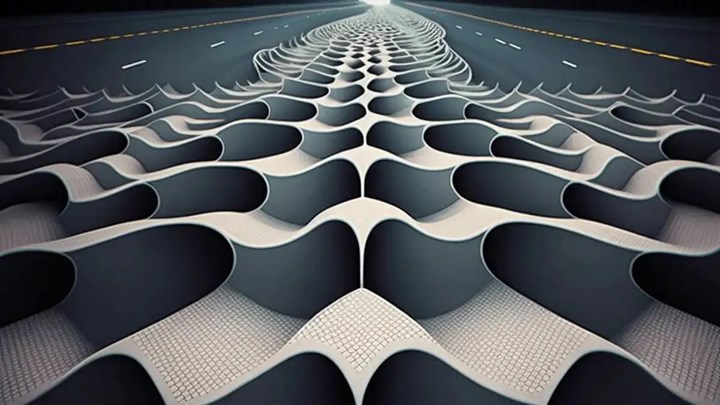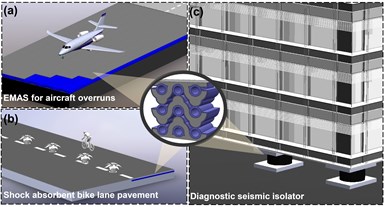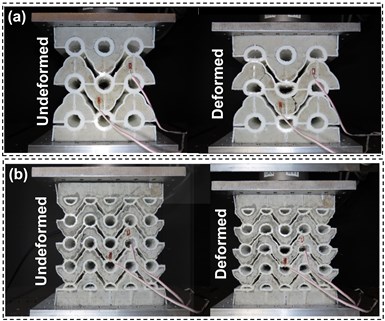21st century concrete: composite metamaterial with super compressability, energy harvesting
Material comprising 3D-printed, auxetic, reinforced polymer lattices in conductive cement matrix can compress up to 15% and generate electricity for lightweight, mechanically tunable structures with energy harvesting and sensing.
Concrete is the most used material in the construction industry and dates to the Roman Empire. Engineers at the University of Pittsburgh (Pitt, Pittsburgh, Pa., U.S.) Swanson School of Engineering are now re-imagining its design for the 21st century.
New research introduces metamaterial concrete for the development of smart civil infrastructure systems. The paper, "Multifunctional Nanogenerator-Integrated Metamaterial Concrete Systems for Smart Civil Infrastructure," presents a new concept for lightweight and mechanically tunable concrete systems that have integrated energy harvesting and sensing functionality.
Future relevance of the proposed nanogenerator-integrated metamaterial concrete in smart infrastructure systems: a) A high energy absorbing engineered materials arresting system; b) A shock absorbent bike lane pavement; c) Metamaterial concrete base isolation system. Photo Credit: Fig. 5, “Multifunctional Nanogenerator-Integrated Metamaterial Concrete Systems for Smart Civil Infrastructure” by Kaveh Barri, Amir Alavi, et al., Adv. Mater. 2023, 2211027.
“Modern society has been using concrete in construction for hundreds of years,” says Amir Alavi, assistant professor of civil and environmental engineering at Pitt, who is the corresponding author on the study. “Our massive use of concrete in infrastructure highlights the need for developing a new generation of concrete materials that are more economical and environmentally sustainable yet offer advanced functionalities. We believe that we can achieve all of these goals by introducing a metamaterial paradigm into the development of construction materials.”
Alavi and his team have previously developed self-aware metamaterials and explored their use in applications like smart implants. This new study introduces the use of metamaterials in the creation of concrete, making it possible for the material to be specifically designed and tailored in its attributes such as load-bearing capability, flexibility and shapeability. These can be fine-tuned in the creation of the material, enabling builders to use less material without sacrificing strength or durability.
Multifunctional metamaterial concrete. a) Schematic of metamaterial concrete with 3 × 3 unit cells. b) Composition of nanogenerator-integrated metamaterial concrete matrix with embedded conductive and non-conductive layers. c) Working mechanism of the unit cells of a nanogenerator-integrated metamaterial concrete. Photo Credit: Fig. 1, “Multifunctional Nanogenerator-Integrated Metamaterial Concrete Systems for Smart Civil Infrastructure”.
“This project presents the first composite metamaterial concrete with super compressibility and energy harvesting capability,” said Alavi. “Such lightweight and mechanically tunable concrete systems can open a door to the use of concrete in various applications such as shock absorbing engineered materials at airports to help slow runaway planes or seismic isolation systems.”
The material is also capable of generating electricity — not enough to send power to the electrical grid, but more than enough to power roadside sensors. The electrical signals self-generated by the metamaterial concrete under mechanical excitations can also be used to perform structural health monitoring (SHM), measuring damage inside the concrete structure or to monitor loads and stresses during earthquakes.
Eventually, these smart structures may even power chips embedded inside roads to help self-driving cars navigate on highways when GPS signals are too weak, or when LIDAR is not working.
Super-compressible metamaterial concrete systems fabricated at the University of Pittsburgh with 3×3 unit cells (left) and 5×5 unit cells (right). The proposed concrete systems are tuned to achieve up to 15% compressibility under cycling loading. Photo Credit: Fig.2, “Multifunctional Nanogenerator-Integrated Metamaterial Concrete Systems for Smart Civil Infrastructure”.
The material developed at Pitt comprises reinforced auxetic polymer lattices embedded in a conductive cement matrix. The composite structure induces contact-electrification between the layers when triggered mechanically. The conductive cement, which is enhanced with graphite powder, serves as the electrode in the system. Experimental studies show that the material can compress up to 15% under cyclic loading and produce 330 microwatts of power.
Alavi and his research team are partnering with the Pennsylvania Department of Transportation (PennDOT) through the IRISE Consortium at Pitt to develop this metamaterial concrete for use on Pennsylvania roads. The project also included researchers from Johns Hopkins University, New Mexico State University, the Georgia Institute of Technology and the Beijing Institute of Nanoenergy and Nanosystems.
Related Content
Composite rebar for future infrastructure
GFRP eliminates risk of corrosion and increases durability fourfold for reinforced concrete that meets future demands as traffic, urbanization and extreme weather increase.
Read MoreA new era for ceramic matrix composites
CMC is expanding, with new fiber production in Europe, faster processes and higher temperature materials enabling applications for industry, hypersonics and New Space.
Read MoreLarge-format 3D printing enables toolless, rapid production for AUVs
Dive Technologies started by 3D printing prototypes of its composite autonomous underwater vehicles, but AM became the solution for customizable, toolless production.
Read MoreMaterials & Processes: Fabrication methods
There are numerous methods for fabricating composite components. Selection of a method for a particular part, therefore, will depend on the materials, the part design and end-use or application. Here's a guide to selection.
Read MoreRead Next
Composites end markets: Energy (2024)
Composites are used widely in oil/gas, wind and other renewable energy applications. Despite market challenges, growth potential and innovation for composites continue.
Read MoreFrom the CW Archives: The tale of the thermoplastic cryotank
In 2006, guest columnist Bob Hartunian related the story of his efforts two decades prior, while at McDonnell Douglas, to develop a thermoplastic composite crytank for hydrogen storage. He learned a lot of lessons.
Read MoreCW’s 2024 Top Shops survey offers new approach to benchmarking
Respondents that complete the survey by April 30, 2024, have the chance to be recognized as an honoree.
Read More






























